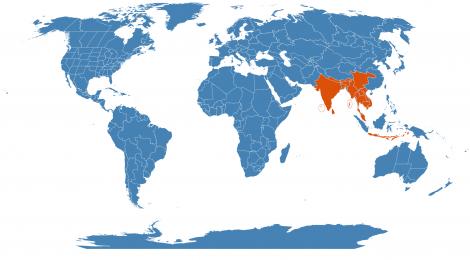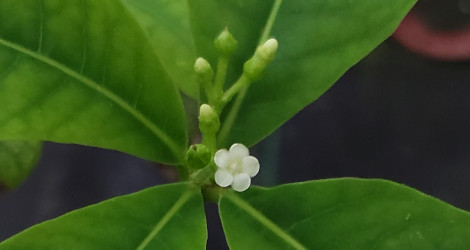Accession Data:
Rauvolfia serpentina (L.) Benth. ex Kurz.
- Common Name: Rauvolfia root, serpentine
- Family: Apocynaceae Juss.
- Country of Origin: Indian Subcontinent to SC. China and W. Malesia

- Habitat: Moist forests shady places near rain-forest
- Description: Source of the medical alkaloid reserpine
- Uses: Very well known in Ayurveda Medicine not as Rauvolfia but as Nakuli, Candrika, or Chandramarah. Specific disorders this plant targets is vaginitis, drug addition, mental and neurological diseases. This plant is bitter, dry and pungent after digestion. It is capable of balancing Vata and Pitta vedas.
It is used for high blood pressure as it has sedative effects on the body; dilation of blood vessels. Some Ayurveda treatments include using the plant to aide in schizophrenia, anxiety, psychosis and other mental disorders.
For women, this herb has been used to regulate menstruation, fertility and even help strengthen contractions during child labor.
- IMPORTANT NOTE: Plant Uses are for informational purposes only. EEB Greenhouses assume no responsibility for adverse effects from the use of any plants referred to on this site. Always seek advice from a professional before using any plant medicinally.
Accession Data:
- Accession # 199200525
- Source: Smith College
- Provenance:
Tracking down old info indicates this is 'probably' Smith# 783-77, originally obtained from Wellesley College. From personal communication with Rob Nicholson, 13 Nov 2002)
- Accession Date: 12-31-1992
- Bench: 1220 - AUS:East Bench SS
- Currently: active - healthy
- Qty: 2 confirmed on 07-01-2025
- Restrictions:
- CITES Appendix II Listed Plant
- CITES Appendix II Listed Plant
Classification:
- Division: Magnoliophyta
- Class: Magnoliopsida
- SubClass: euasterid I
- Order: Gentianales
- SubOrder:
- Family: Apocynaceae
- SubFamily: Rauvolfioideae
- Tribe: Vinceae
- SubTribe:
Flowering Data:
This accession has been observed in bloom on:| Year | Jan | Feb | Mar | Apr | May | Jun | Jul | Aug | Sep | Oct | Nov | Dec | ||||||||||||||||||||||||||||||||||||||||
|---|---|---|---|---|---|---|---|---|---|---|---|---|---|---|---|---|---|---|---|---|---|---|---|---|---|---|---|---|---|---|---|---|---|---|---|---|---|---|---|---|---|---|---|---|---|---|---|---|---|---|---|---|
| 2025 | ||||||||||||||||||||||||||||||||||||||||||||||||||||
| 2024 | ||||||||||||||||||||||||||||||||||||||||||||||||||||
| 2023 | ||||||||||||||||||||||||||||||||||||||||||||||||||||
| 2022 | ||||||||||||||||||||||||||||||||||||||||||||||||||||
| 2021 | ||||||||||||||||||||||||||||||||||||||||||||||||||||
| 2020 | ||||||||||||||||||||||||||||||||||||||||||||||||||||
| 2019 | ||||||||||||||||||||||||||||||||||||||||||||||||||||
| 2018 | ||||||||||||||||||||||||||||||||||||||||||||||||||||
| 2017 | ||||||||||||||||||||||||||||||||||||||||||||||||||||
| 2016 | ||||||||||||||||||||||||||||||||||||||||||||||||||||
| 2015 | ||||||||||||||||||||||||||||||||||||||||||||||||||||
| 2014 | ||||||||||||||||||||||||||||||||||||||||||||||||||||
| 2013 | ||||||||||||||||||||||||||||||||||||||||||||||||||||
| 2012 | ||||||||||||||||||||||||||||||||||||||||||||||||||||
| 2011 | ||||||||||||||||||||||||||||||||||||||||||||||||||||
| 2010 | ||||||||||||||||||||||||||||||||||||||||||||||||||||
| 2009 | ||||||||||||||||||||||||||||||||||||||||||||||||||||
References (internal):
- Medicinal Plants
- Medicinal Plants - Ayurveda Medicine
- EEB 3271 - Systematic Botany
- Currently Featured Medicinal Plants
- EEB Greenhouse Holdings native to: China South-Central / Assam / Bangladesh / East Himalaya / India / Laccadive Is. / Nepal / Sri Lanka / Andaman Is. / Cambodia / Laos / Myanmar / Thailand / Vietnam / Jawa / Lesser Sunda Is. / Malaya
References (external):
- Lonely Traveler blog - visited 2 January 2012
- The Plant List (2013). Version 1.1. Accessed 27 February 2015.
- WCSP (2015). World Checklist of Selected Plant Families. Facilitated by the Royal Botanic Gardens, Kew. Accessed 27 February 2015.
- R. Kumari, B. Rathi, A. Rani, S. Bhatnagar Rauvolfia serpentina L. Benth. ex Kurz.: Phytochemical, Pharmacological and Therapeutic Aspects Int. J. Pharm. Sci. Rev. Res., 23(2), Nov–Dec2013; nᵒ 56, 348-355. Last accessed on Thursday, February 08, 2018.
data regenerated on Tue, 01 Jul 2025 11:33:10 -0400 [bcm v4.0]
Images:

Additional images for this accession:
Click on thumbnails to enlargeCurrent Accessions in the Apocynaceae
Subfamily Apocynoideae
Tribe Apocyneae
Subfamily Apocynoideae
Tribe Malouetieae
Subfamily Apocynoideae
Tribe Mesechiteae
Subfamily Apocynoideae
Tribe Nerieae
Subfamily Apocynoideae
Tribe Wrightieae
Subfamily Asclepiadoideae
Tribe Asclepiadeae
- Asclepiadinae: Asclepias curassavica


- Asclepiadinae: Asclepias tuberosa


- Asclepiadinae: Gomphocarpus fruticosus


- Cynanchinae: Cynanchum grandidieri W/C


- Cynanchinae: Cynanchum marnierianum


- Cynanchinae: Cynanchum pachycladon

- Cynanchinae: Cynanchum sp.
- Cynanchinae: Cynanchum verrucosum

Subfamily Asclepiadoideae
Tribe Ceropegieae
- Stapelieae: Caralluma hesperidum

- Stapeliinae: Ceropegia albisepta W/C

- Stapeliinae: Ceropegia ampliata


- Stapeliinae: Ceropegia ampliata


- Stapeliinae: Ceropegia aristolochioides

- Stapeliinae: Ceropegia cimiciodora
- Stapeliinae: Ceropegia fusca

- Stapeliinae: Ceropegia linearis subsp. woodii

- Stapeliinae: Ceropegia x rothii
- Stapeliinae: Ceropegia stapeliiformis


- Stapeliinae: Edithcolea grandis

- Stapeliinae: Hoodia gordonii

- Stapeliinae: Huernia piersii

- Stapeliinae: Huernia plowesii


- Stapeliinae: Huernia thureti var. thureti


- Stapeliinae: Huernia zebrina

- Stapeliinae: Larryleachia cactiformis

- Stapeliinae: Stapelia flavopurpurea


- Stapeliinae: Stapelia gigantea


- Stapeliinae: Stapelia grandiflora

- Stapeliinae: Stapelianthus madagascariensis


Subfamily Asclepiadoideae
Tribe Fockeeae
Subfamily Asclepiadoideae
Tribe Marsdenieae
- Dischidia albiflora


- Dischidia bengalensis

- Dischidia litoralis

- Dischidia major


- Dischidia ovata
- Dischidia ruscifolia

- Hoya australis ssp. australis
- Hoya carnosa


- Hoya carnosa x serpens

- Hoya curtisii
- Hoya imbricata

- Hoya imbricata

- Hoya macgillivrayi


- Hoya macrophylla

- Hoya obovata


- Hoya pubicalyx

- Hoya retusa
- Marsdenia floribunda


Subfamily Periplocoideae
Tribe Cryptolepideae
Subfamily Periplocoideae
Tribe Periploceae
Subfamily Rauvolfioideae
Tribe Alyxieae
Subfamily Rauvolfioideae
Tribe Carisseae
Subfamily Rauvolfioideae
Tribe Plumerieae
Subfamily Rauvolfioideae
Tribe Tabernaemontaneae
- Tabernaemontaninae: Tabernaemontana divaricata


- Tabernaemontaninae: Tabernaemontana elegans


Subfamily Rauvolfioideae
Tribe Vinceae
- Catharanthus roseus



- Rauvolfia serpentina



- Ochrosiinae: Ochrosia elliptica


 = indicates flowering in past 14 days
= indicates flowering in past 14 days
 = images available for this accession
= images available for this accession
 = map available for this accession
= map available for this accession
 = accession added within past 90 days
= accession added within past 90 days